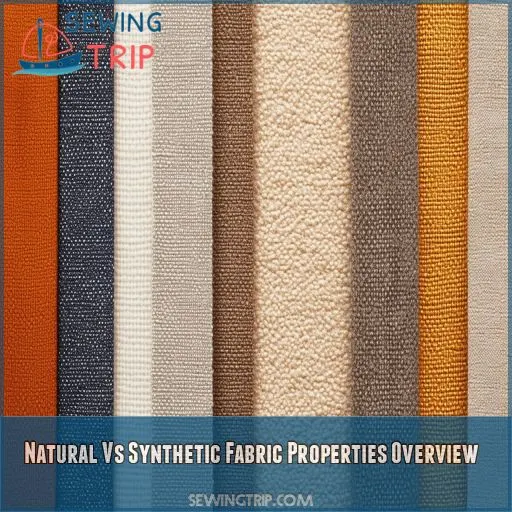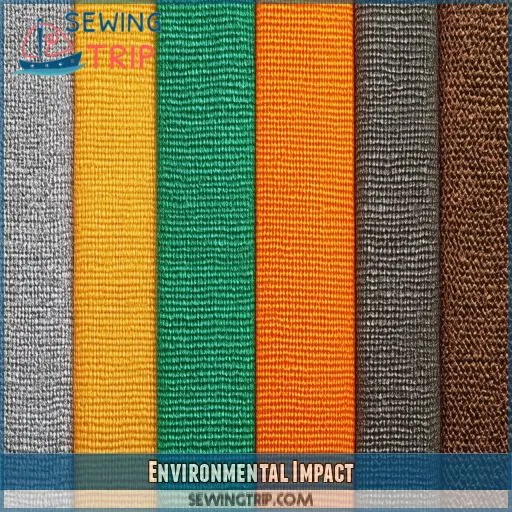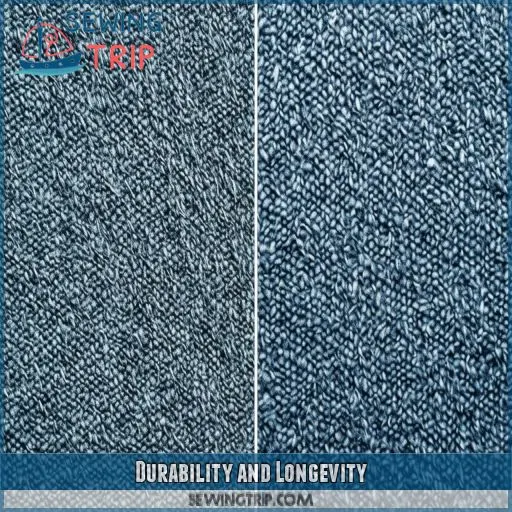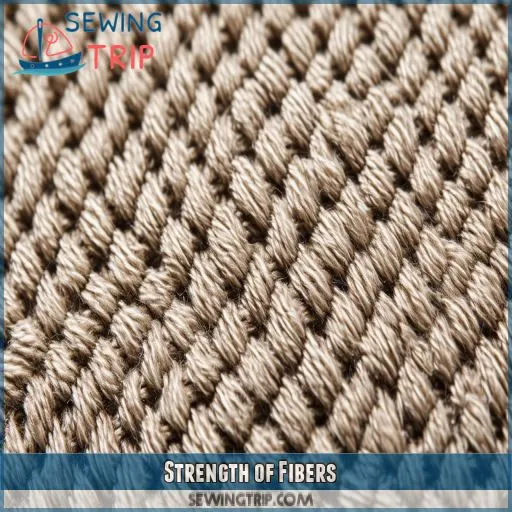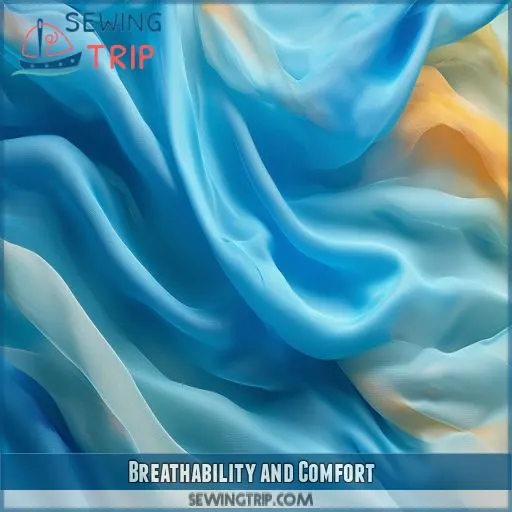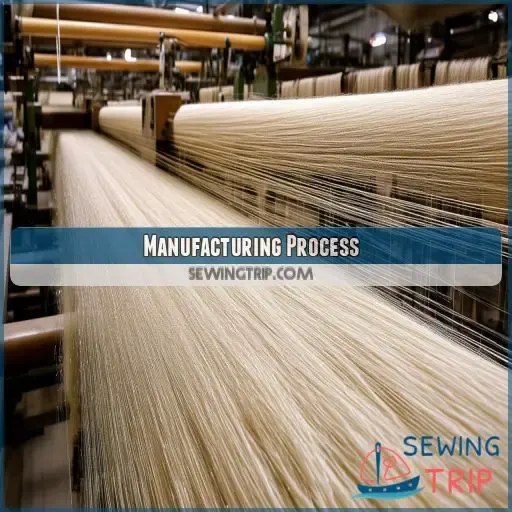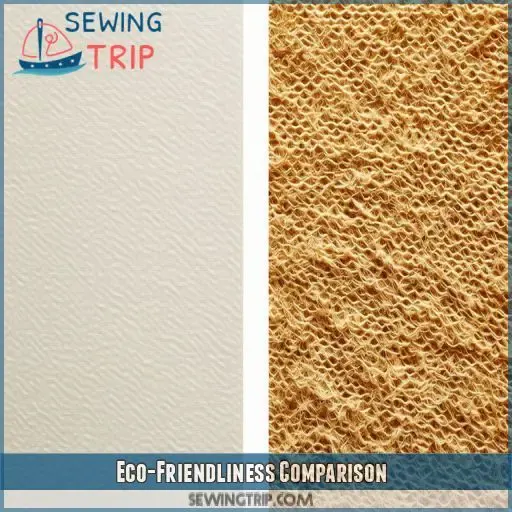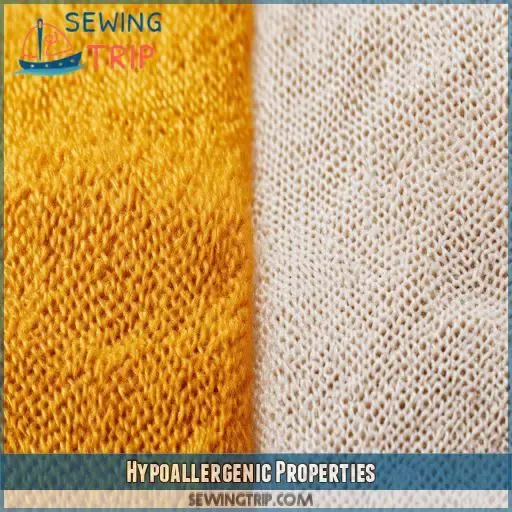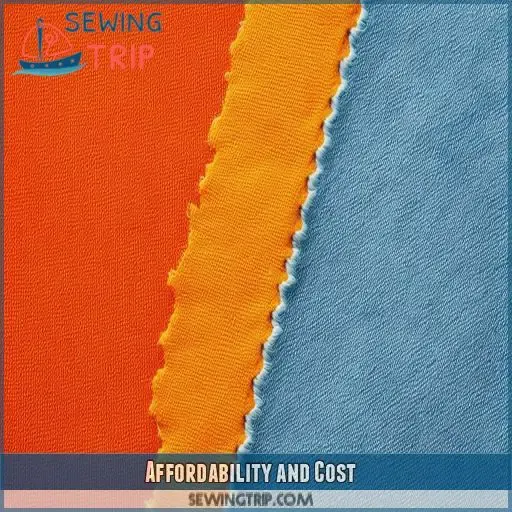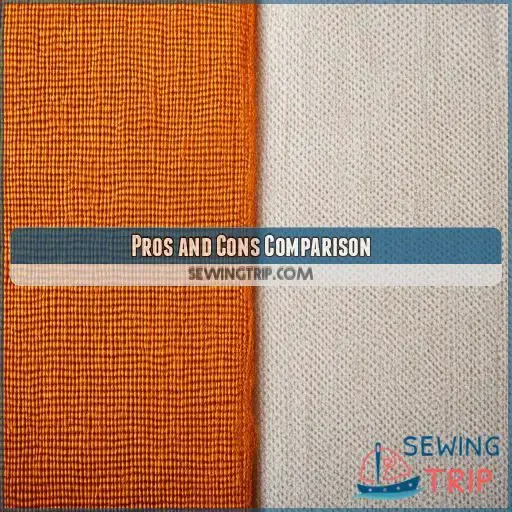This site is supported by our readers. We may earn a commission, at no cost to you, if you purchase through links.
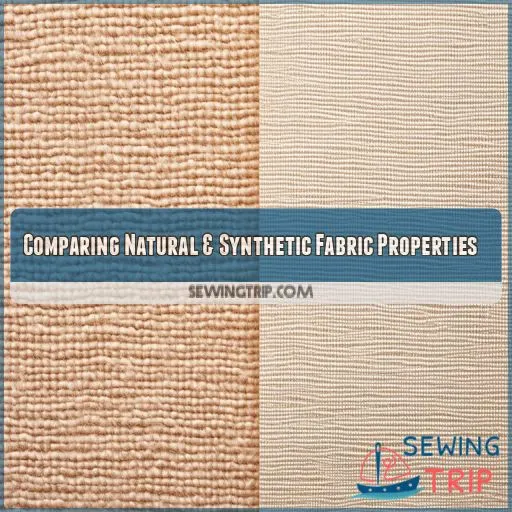
Exploring the characteristics of natural versus synthetic fabrics offers illuminating insights. Both types boast unique advantages and disadvantages.
Compare their attributes from eco-friendliness and renewability to durability and cost.
Consider factors such as biodegradability, pollution, lifespan, hypoallergenicity, and manufacturing processes.
Empower yourself with valuable knowledge before embarking on the intriguing journey of fabric selection.
Table Of Contents
- Key Takeaways
- Natural Vs Synthetic Fabric Properties Overview
- Environmental Impact
- Durability and Longevity
- Strength of Fibers
- Breathability and Comfort
- Manufacturing Process
- Eco-Friendliness Comparison
- Hypoallergenic Properties
- Affordability and Cost
- Pros and Cons Comparison
- Frequently Asked Questions (FAQs)
- Conclusion
Key Takeaways
- "Breathe easy with naturals": Natural fabrics, like cotton and linen, are champions of breathability and comfort. They allow better air circulation, manage moisture, and feel gentler on the skin compared to synthetic fibers, which might trap heat and moisture, possibly causing skin irritations. Perfect for those hot summer days!
- "Durable delights in synthetics": Synthetic fibers, such as polyester and nylon, really bring home the bacon when it comes to durability and longevity. Superior resistance to wear and tear combined with minimal maintenance makes these materials ideal for everyday wear or adventure-seekers who aren’t afraid to put their clothes through the wringer (literally).
- "Mother Nature matters": Though natural fibers can consume more water, responsible farming practices can help alleviate this concern. Meanwhile, synthetic fibers, primarily derived from fossil fuels, add fuel to the fire in terms of pollution and non-renewable resource utilization. By going green with natural fibers, you’ll be helping preserve our planet for future generations.
- "It’s all about balance": At the end of the day, choosing the perfect fabric largely depends on striking the right balance between durability, breathability, comfort, and environmental impact according to one’s personal preferences and requirements. Don’t shy away from blending both worlds either – combining natural and synthetic fibers gives you the best of both realms with improved durability, wrinkle resistance, and cost-effectiveness while maintaining some breathability and hypoallergenicity.
Natural Vs Synthetic Fabric Properties Overview
When comparing natural and synthetic fabric properties, several factors come into play. Natural fibers like cotton, linen, and wool are biodegradable, making them environmentally friendlier than their synthetic counterparts. They derive from renewable sources, supporting local communities and reducing pollution. However, they might require more care and maintenance.
On the other hand, synthetic fibers such as polyester and nylon excel in durability and longevity. Their resistance to wear and tear ensures a longer lifespan, and they typically demand less maintenance. Additionally, synthetic fibers offer impressive strength, stain resistance, and cost-effectiveness. Yet, they lack biodegradability and often stem from non-renewable resources.
When considering breathability and comfort, natural fibers shine due to their ability to promote better air circulation, managing moisture effectively. This characteristic contributes to their hypoallergenic nature, benefiting those with sensitive skin. Meanwhile, synthetic fabrics tend to be less breathable, potentially causing discomfort and skin irritations. Ultimately, choosing the right fabric depends on personal preference, garment purpose, skin sensitivity, and environmental concerns.
Environmental Impact
When comparing natural and synthetic fabrics’ environmental impact, consider two key factors: biodegradability and renewable sourcing versus pollution and land use. While natural fibers are biodegradable and renewable, they can still consume substantial water and land resources. On the other hand, synthetic fibers, primarily derived from fossil fuels, contribute to pollution and strain environmental resources due to their non-biodegradable nature.
Biodegradability and Renewable Sourcing
When considering environmental impact, biodegradability matters. Naturally sourced fibers like cotton and linen break down quickly, unlike their synthetic counterparts such as polyester and nylon. Here’s why it counts:
Pollution and Land Use
As we continue exploring fabric properties, let’s examine the environmental impact concerning pollution and land use. Both categories pose significant concerns, especially given the rising demand for textiles. Here’s a quick comparison:
| Category | Natural Fibers | Synthetic Fibers |
|---|---|---|
| Water Consumption | Generally higher; variable based on crop type | Much lower |
| Land Degradation | Can lead to erosion if mismanaged | Linked to resource extraction |
| Eco-friendly Manufacturing | Often requires fewer chemicals and lower energy | Reliant on petrochemicals |
Although natural fibers consume more water, responsible farming practices can mitigate this issue. Meanwhile, synthetic fibers’ reliance on finite resources raises serious ecological questions. Keep these factors in mind next time you shop!
Durability and Longevity
When comparing natural and synthetic fabrics, consider their ability to withstand wear and tear. While natural fibers like cotton and wool may need more careful handling, synthetic fibers such as polyester and nylon excel in durability and longevity, maintaining shape and resisting damage despite frequent use.
Wear and Tear Resistance
When considering fabric durability, pay attention to abrasion resistance, tearing strength, pilling tendency, fade resistance, and shrinkage control. High-quality synthetics like polyester and nylon shine in this regard, boasting superior resistance to daily wear and tear. Here’s a quick rundown:
- Abrasion resistance: Synthetics win hands down.
- Tearing strength: Both naturals and synthetics perform well, but blends offer a nice middle ground.
- Pilling tendency: Naturals, particularly wool, are susceptible; synthetics fair much better.
- Fade resistance: Synthetics retain vibrant colors longer than most naturals.
- Shrinkage control: Generally, synthetics triumph in stabilty under heat and agitation.
Lifespan Comparison
When comparing the lifespans of natural and synthetic fabrics, synthetic fibers like polyester and nylon usually win due to superior resistance against wear and tear.
However, this doesn’t mean natural fibers lack durability entirely; cotton and wool, for instance, prove quite robust given proper care.
Ultimately, understanding your needs and priorities will guide you best in selecting the most fitting material for your lifestyle and wardrobe preferences.
Strength of Fibers
Now that you’re familiar with the durability and longevity of natural and synthetic fibers, let’s explore the strength of these materials. A strong fiber contributes to the overall durability of a fabric, ensuring it withstands daily wear and tear. Here are some factors to examine when comparing the strength of natural and synthetic fibers:
- Tensile strength: This measures the amount of force required to break a single fiber. Generally, synthetic fibers excel in this category due to their molecular structure. For instance, both nylon and polyester boast higher tensile strengths than natural fibers like cotton and silk.
- Tear resistance: This aspect focuses on a material’s ability to resist tearing upon applying pressure. Longer fiber lengths usually result in greater tear resistance. While some natural fibers, like wool and silk, possess impressive fiber lengths, many synthetic fibers are specifically engineered for enhanced tear resistance.
- Elasticity: Certain synthetic fibers exhibit excellent recovery rates after stretching—an attribute linked to their elasticity. However, several natural fibers, including rubber and certain forms of animal hair, can rival synthetic competitors regarding elasticity.
Keep in mind that other factors, such as absorbency and breathability, play substantial roles in assessing fabric performance; however, those topics will be covered later.
Breathability and Comfort
Turning to breathability and comfort, notice how natural fibers excel in promoting air circulation, managing moisture, and feeling gentle on the skin. On the other hand, synthetic fabrics might lag behind in these areas, possibly causing discomfort and skin sensitivities.
Airflow and Moisture Management
Natural fibers, like cotton and linen, excel in breathability due to their porous nature, absorbing moisture and promoting air circulation. This leads to better body temperature regulation and reduced odor.
Synthetic fibers focus on quick-drying and sweat-wicking technologies, moving moisture away from the skin.
Both types have pros and cons, so choose based on your needs and priorities.
Skin-Friendly Materials
Moving on to skin-friendly materials, let’s talk about breathability and comfort.
Natural fibers like cotton and linen are gentler on your skin since they allow better air circulation and absorb moisture efficiently.
On the flip side, synthetic fibers might trap heat and moisture, possibly causing skin irritations, allergies, or exacerbating issues like eczema and dermatitis.
So, if you have sensitive skin, opting for natural fabrics could save you from potential discomfort.
Keep in mind that affordable, mold-resistant choices like lyocell can cater to budget-conscious consumers seeking hypoallergenic, comfy attire.
Manufacturing Process
As you explore the manufacturing process of natural and synthetic fabrics, consider two key points: first, the contrasting approaches of chemical reactions versus sustainable practices in creating these materials, and second, the varying strengths of resulting fibers.
Chemical Vs Sustainable Practices
Moving forward, let’ consider the manufacturing process. Here, stark differences emerge between natural and synthetic fabric production. While synthetic fibers undergo complex chemical processing involving polluting chemicals, natural fibers focus on sustainable sourcing, preserving natural resources, and eco-friendly manufacturing. Your fabric choice affects environmental concerns, cost, and even garment purpose – so choose wisely!
Fiber Strength
For fiber strength, synthetic fabrics excel. They resist wear, thanks to high tensile strength and abrasion resistance. Plus, they offer excellent tear resistance and elasticity, making them great for sportswear and outdoor gear.
Blended fabrics combine the best of both worlds, balancing natural softness with synthetic durability.
Impurities must be removed during production for good dye compatibility and thermal regulation.
Eco-Friendliness Comparison
When comparing natural and synthetic fabrics’ eco-friendliness, there are some key factors to assess. First, think about biodegradability. Natural fibers, being plant or animal-based, decompose organically without causing harm. On the flip side, most synthetic fibers, produced from petroleum products, don’t break down readily, contributing to waste buildup.
Next, let’s talk water and land usage. Growing crops for natural fibers demands substantial resources—think acres of farmland and gallons upon gallons of irrigation water. Meanwhile, extracting crude oil to manufacture synthetics poses different ecological challenges, affecting habitats and threatening biodiversity.
Keep in mind that neither category holds a definitive edge across every aspect; each comes with pros and cons. Your decision might depend on personal preferences, budget constraints, or simply whether prioritizing environmental sustainability matters most to you. And hey, did someone say hybrid fabrics? That could open another door worth exploring…
Hypoallergenic Properties
When considering hypoallergenic properties, natural fibers come out on top. Here’s why:
- Allergic Reactions: Organic fibers like cotton, silk, and linen are less likely to cause allergic reactions or skin irritations than synthetic ones.
- Sensitive Skin: If you have sensitive skin, opting for natural fabrics can save you from uncomfortable rashes and inflammations.
- Chemical Treatments: Many synthetic fabrics undergo chemical treatments that might lead to contact dermatitis. With natural fibers, this risk is greatly reduced.
- Organic Fibers: Garments made from organically grown fibers further minimize the chances of triggering allergies or skin issues.
Affordability and Cost
Now let’s explore the affordability and cost aspects of natural and synthetic fabrics.
When comparing prices, synthetic fibers like polyester typically have a lower cost per yard than natural ones such as cotton or silk. This difference is mainly due to the production costs involved – while natural fibers rely on farming and livestock rearing, synthetic fibers are created through chemical processes that can be scaled up more efficiently.
However, keep in mind that material sourcing also impacts the final price tag. Organic cotton or cruelty-free silk might carry a premium over conventional options. On the other hand, bulk discounts may apply when purchasing large quantities of synthetic fabrics.
Moreover, remember that cheaper doesn’t always mean better. Some high-quality natural fabrics may last longer than cheap synthetics, justifying their higher price points in the long run. So, weigh all factors before deciding based solely on sticker shock.
Here’s a simple table summarizing some key differences:
| Aspect | Natural Fibers | Synthetic Fibers |
|---|---|---|
| Price Point | Higher | Lower |
| Cost Per Yard | Variable | Generally Low |
| Production Costs | Higher | Lower |
| Bulk Discounts | Sometimes | Often Available |
Pros and Cons Comparison
Regarding natural fibers, they offer several advantages: biodegradability, reduced pollution, breathability, and comfort. However, there are also drawbacks, such as higher water consumption, susceptibility to damage, varying strength among different fibers, and sometimes intensive farming practices that could lead to land degradation.
In contrast, synthetic fibers provide benefits such as impressive durability, stain resistance, vibrant color retention, and easy care. Nevertheless, they come with their own set of issues; namely, non-biodegradability causing long-term pollution, potential harm caused by microplastic shedding, compromised breathability, and often being derived from non-renewable sources.
Frequently Asked Questions (FAQs)
What are the properties of natural and synthetic fabrics?
Natural fabrics, like cotton, excel in breathability and comfort. They’re biodegradable and skin-friendly. Synthetic fabrics, like polyester, shine in durability and stain resistance. However, they’re less breathable and contribute to pollution. Choose based on purpose, preference, skin sensitivity, and environmental stance.
What are 3 differences between natural and synthetic fabrics?
Choose wisely: natural fabrics breathe yet need care; synthetics shine in durability and cost, but lack breathability. Assess your needs and priorities before deciding.
Is it better to use natural or synthetic material to?
When selecting fabric, consider your needs first. If breathing room and gentleness on skin matter most, natural materials shine. But if durability and cost-effectiveness top your list, synthetics may be your best bet. It’s horses for courses in this case!
What are the pros and cons of natural vs synthetic materials?
When deciding between natural and synthetic materials, consider your needs. Natural fibers like cotton offer breathability and comfort but require more care. Synthetics, like polyester, excel in durability and stain resistance but lack breathability. Both types have pros and cons, so choose what suits your lifestyle best.
How do cleaning methods affect fabric life?
Choose wisely when cleaning fabrics: gentle methods like hand washing or dry cleaning can extend fabric life, while harsh chemicals can be a recipe for disaster. Remember, an ounce of prevention is worth a pound of cure.
Are synthetic fabrics more prone to static?
Yes, synthetic fabrics like polyester are more prone to static due to their chemical composition. This causes electrons to become unbalanced, leading to static electricity buildup and cling. Swap those synthetics for natural alternatives, like cotton or wool, to minimize static shock.
Can natural fibers be blended with synthetics?
Combining natural and synthetic fibers creates blends boasting enhanced durability, wrinkle resistance, and cost-effectiveness. These hybrids also maintain some breathability and hypoallergenicity of their natural components.
What temperatures suit each fabric type in washing?
When laundering, remember this rule: colder is better for naturals like cotton or wool, while warmth suits synthetics such as polyester or nylon. This simple tip prolongs fabric life and guarantees effective cleaning!
Which fabric dyes best retain vibrancy over time?
For vibrant colors, consider natural fibers like cotton and silk. They retain dye better than synthetics since they absorb dye deeper into their structures, ensuring lasting vividness. Choose wisely!
Conclusion
Choosing between natural and synthetic fabrics involves weighing various factors.
Understanding the intricacies of their properties can feel like traversing a labyrinth. However, once clarified, selecting suitable fabrics becomes effortless.
Opt for natural fibers such as cotton for breathability; consider synthetics like polyester for durability and lower costs.
Prioritize eco-friendliness, considering both biodegradability and reduced pollution.

